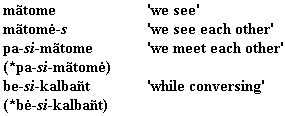A)Clitics can exhibit a low degree of selection with respect to their hosts, while affixes exhibit a high degree of selection with respect to their stems.
B)Arbitrary gaps in the sets of combinations are more characteristic of affixed words than of clitic groups.
C)Morphophonological idiosyncrasies are more characteristic of affixed words than of clitic groups.
D)Semantic idiosyncrasies are more characteristic of affixed words than of clitic groups.
E)Syntactic rules can affect affixed words but cannot affect clitic groups.
F)Clitics can attach to material already containing clitics but affixes cannot.
No syntactic rule can have access to or affect the internal structure of a word. (p.97)
This therefore implies that no language will have word-internal placement of clitics, or endoclitics, contradicting the Wackernagel behaviour of -s(i), as summarised above. Nevis and Joseph attempt to get round this by suggesting that "-s(i) would be an instantiation of a new type of mobile affix� one that moves within a word, in keeping with a version of Wackernagel's Law at word level" (p.97). They reinforce this view by applying a set of criteria to s(i). These selected criteria are a representation of the Zwicky and Pullum criteria but are "repeated and elaborated upon" (p.98) so as to state the most relevant tests applicable in this particular case:
a)Affixes exhibit a high degree of selection with respect to their hosts; clitics exhibit a low degree of host selection.
b)Unpredictable gaps in the combinatory possibilities are more characteristic of affixed words than of clitic groups.
c)Syntactic rules can affect affixed words as a whole, but not affixes as individual pieces of words.
d)Morphophonological idiosyncrasies are characteristic of affixes, not of clitics.

![]()
They conclude from their findings that Lithuanian -s(i)- is best taken to be an affix despite its mobility, and account for its variable position by referring to it as a word-level instantiation of Wackernagel's Law.
"Affixes, as prototypical bound elements, are generally considered to occur in a relatively fixed position (or 'slot') within their host words, and in a fixed position with respect to other affixes. Zwicky and Pullum (1983), for instance, give this criterion as one of several that distinguishes bound elements, i.e. affixes and clitics, from free elements, i.e. words, and which differentiate affixes from nonaffixes, i.e. clitics and words. "Despite the importance of ordering restrictions as a way of identifying bound elements, there are some affixes or affix-like elements attested in various languages of the world that show variable placement with respect to their host." (p.93)
c. high degree of combinatory selectivity (affix) vs. low degree (nonaffix)
d. occurrence of gaps in combinatory possibilities (affix) vs. no such gaps (nonaffix)
e. not manipulable by the syntax (affix) vs. availability to syntactic operations (nonaffix)
f. morpho(phono)logical idiosyncrasies (affix) vs. no such idiosyncrasies (nonaffix)
g. semantic idiosyncrasies (affix) vs. no such idiosyncrasies (non-affix)
h. interior position within word (affix) vs. exterior position (nonaffix)
![]()

affix : word :: clitic : phrase/sentence
i.e. affixes will attach to their words in the same way that clitics attach to their phrases or sentences. This is fine as far as it goes, but N&J neglect the clitics' other dimension, making their analogy incomplete. They must consider the following as well:
"affix" : adjacent morpheme :: clitic : host word
i.e. an affix-like element exhibiting clitic behaviour must attach to an adjacent morpheme in the same way that known clitics liaise with, or phonologically attach to, an adjacent word. Z&P actually say, "The degree of selection between the clitics and the words preceding them is low" (p.504, emphasis ours). That is, a clitic's promiscuous behaviour is with respect to its host word, meaning that N&J's so-called Wackernagel affix will have to pay attention to (or not, as the case may be) the immediately preceding morpheme. Looking at N&J's own data, we are confronted with distinctly clitic-like behaviour, as the reflexive attaches to all manner of different morphemes:



References
Baker, M. 1985. The Mirror Principle and Morphosyntactic Explanation. Linguistic Inquiry 16, 373- 416.
Carstairs-McCarthy, A. 1993. Current Morphology. London: Routledge.
Crystal, D. 1991. A Dictionary of Linguistics and Phonetics. Oxford: Blackwell.
Giegerich, H.J. 1992. English Phonology: An Introduction. Cambridge: CUP.
Kanerva, J. 1987. Morphological Integrity and Syntax: the Evidence from Finnish Possessive Suffixes. Language 63, 498-521.
Katamba, F. 1993. Morphology. Basingstoke: Macmillan.
Klavans, J. 1985. The Independence of Syntax and Phonology in Cliticization. Language 61, 95-120.
Matthews, P.H. 1991. Morphology, 2nd ed. Cambridge: CUP.
Nevis, J. & B. Joseph. 1992. Wackernagel Affixes: Evidence from Balto-Slavic. In G. Booij and J. van Marle (eds.), Yearbook of Morphology 1992, 93-111.
Sadock, J. 1991. Autolexical Syntax. A Theory of Parallel Grammatical Representations. Chicago: Chicago University Press.
Spencer, A. 1991. Morphological Theory. Oxford: Blackwell.
Zwicky, A. & G. Pullum. 1983. Cliticization vs. Inflection: English n't. Language 59, 502-13.
Zwicky, A. 1985. Clitics and Particles. Language 61, 283-305.